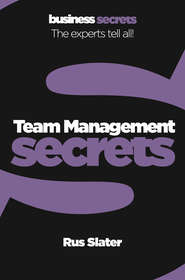По всем вопросам обращайтесь на: info@litportal.ru
(©) 2003-2024.
✖
People Management
Автор
Год написания книги
2019
Настройки чтения
Размер шрифта
Высота строк
Поля
It is probably pretty clear that your life will be more fulfilling and more enjoyable if you are a leader than a manager, but pressure (target-driven organizations, the desire to be indispensable, the feeling of responsibility) tends to encourage micro-management.
You probably need to ‘manage’ people who have little experience and expertise, but as people grow in ability and knowledge you can slowly switch from ‘manager’ to ‘leader’. Of course, if you take over a team that is already performing, you may be able to go straight to leadership and followership from day one.
A leader attracts followers, whereas a manager has to supervise the managed.
1.3 Balance your decisions (#ulink_45a79dca-7ee6-5bd5-b74d-95bae2f3a2f3)
Are you the leader of the team, or the person tasked to get things done, or the person tasked with looking after the individual team members? Actually, if you want to manage people well, you need to take on all three of these roles.
There is a concept called ‘Pyrrhic Victory’, which describes a situation in which an objective has been achieved – but at too high a cost.
• If you make all decisions with the primary objective of achieving the task at any cost, then you might end up destroying the team on the way. But…
• If you make all your decisions with the primary aim of keeping the team intact and happy, then you probably won’t achieve the task But…
• If you are determined to ensure that each and every individual is safe, happy and looked after, then you won’t fulfil the task and the team will fall apart as well.
John Adair, the world’s first Professor of Leadership Studies, developed a model called Action Centred Leadership. His contention is that as a leader or manager you need to ensure that every decision and action you take balances the needs of the task, the team and the individuals. By doing this you stand the greatest chance of achieving the task, having a cohesive and capable team still in place for the next task, and having individuals who still have a good quality of life, and feel valued and respected.
This model is usually represented by three interlocking circles, from which it gets its name, Action Centred Leadership.
Answering yes or no to any of the questions above doesn’t tell you the right thing to do. By asking the questions before you act, you will get a chance to balance your decision.
Balanced decisions every day make for good leadership – not task focused one day, team focused the next!
1.4 Don’t be consistent! (#ulink_960788b1-61f2-50f9-91a0-27c32b9f9542)
“What?” I hear you cry! “Surely I should manage everyone in the same way to be fair?” Well, think about it: imagine you have two people, one is experienced, competent and willing, and the other is new to the task, has little ability and is lazy. Would it be fair to manage each of them in the same way? Would it motivate them both?
You have to manage or lead in a way that suits the situation. This is called Situational Leadership, a title originally coined by Ken Blanchard and Paul Hersey. Here is a simple primer to the idea:
• Consider an individual’s ability on a scale of low to high. This is their ability to do the job you are asking of them, not just a reflection of their age or years of service.
• Next consider their willingness to do this particular job, again on a scale of low to high.
• Now imagine these two values plotted on a graph, like the one opposite.
• The notations on the graph (C, D1, D2, S) refer to the paragraphs below the graph, which tell you how you might best manage this particular person.
• S = Support. This person is very willing but lacking in skill/ability. They need support in terms of demonstrations, training and practice (see Secret 4.8).
• C = Coaching. This person is both willing and able and therefore only needs some light coaching in order to perform well.
• D1 = Directing 1. This person has both low ability and low willingness. They are going to need much more in the way of directing – orders, supervision and checking.
• D2 = Directing 2. This person has already proved their ability but their willingness is low. They don’t need training and demonstration; they need some direction from you to understand why the task is important and how they will benefit personally by doing it well.
It is vital for your success and the success of your people that you manage in a way that suits the situation.
1.5 Learn to delegate (#ulink_09401e32-69d7-5fc9-a258-606a9186a327)
As a manager, team leader, supervisor or foreman, you have to delegate work to others. Delegating is a fundamental skill of management, but it is also one that many managers do very badly. There is a skill to learn in order to delegate effectively.
The more you delegate, the more time you will have to manage people and improve processes. In order to delegate effectively, you need to ensure that the person to whom you delegate a task is provided with four things: Skill, Time, Authority and Responsibility. The first letters of these words spell the word STAR, which makes them easy to remember, as shown below.
• S = Skill. You need to ensure that the person has the skill and ability to do the task. This doesn’t mean that they have to be as good at the task as you. (You may be able to give them more time to do it than you would otherwise have available to do it yourself.)
• T = Time. You need to make sure that the person has adequate time to complete the task at the pace that’s likely for their ability. This means allowing for the actual time this task will take alongside any other tasks they need to do. If you are their manager, they may be reluctant to admit that they don’t have the time. Try to ask open questions (“When will you do this?”) rather than leading questions (“You have enough time to do this, don’t you?”) to ascertain their workload.
• A = Authority. Ensure that other people know that the person you’re delegating to has been given the authority to complete this task. You might just tell people that they will need to provide this person with information and support, or you might give them a written ‘licence’ or acting rank. Without confirmation of authority, their task may be much harder to perform.
• R = Responsibility. This is often the hardest one. You are delegating something that you have a responsibility to get done, so you must ensure that the person you delegate to understands that they are responsible to you for doing the task. One of the best ways to give the responsibility is to make it very clear that you are sharing the credit for the successful outcome.
For more about delegating to motivate people, see Secret 4.7.
The more you can delegate properly the more you can get done, so learn to love delegating.
1.6 Lead by example (#ulink_ac8e2ca0-f6ca-5518-b3db-347187b0d509)
We have already established that it is easier for you if your people want to follow you rather than be ‘the managed’. You have to set a good example for people to copy. Otherwise, you are giving the contradictory message, “Don’t do as I do, do as I say.”
• Leading by example doesn’t mean that you have to do or even be able to do the jobs of everyone who works for you.
• Leading by example doesn’t mean that you have to get as ‘grimy’ as they may have to on a daily basis.
• Leading by example doesn’t mean that you have to earn the same as they do. The extra responsibilities of being the boss usually command a higher rate of pay.
one minute wonder The difficult balancing act is to let people see that you have achieved your elevated position on merit, without making them resent you for the trappings of that achievement. If you can get this balance right, then you are a leader!
What leading by example does mean
You have to set an example all day, every day. People really notice and remember if you fail to ‘walk the talk’.
1.7 Think about TOM (#ulink_e5756223-abf8-59a5-9650-ade0cbad6a88)
TOM is an acronym. It sets out three simple to remember principles that help you manage people effectively. The three principles of TOM are Trust, Objectives and Motivation.
• Trust. You need to build trust with your people. Note the emphasis on trust with, i.e. you trust them and they trust you. You can do this by observing, questioning, listening to and socializing with your people. Manage their expectations and keep your word. Always be reasonable. Building trust takes time, and you don’t command trust just because of your rank or job title. Avoid ‘micro-management’ – don’t expect hourly progress reports. Step back and let people get on without your constant supervision.
• Objectives. You need to set objectives that have clear desired outcomes. These can be short-, medium- or long-term objectives. They can be based around activity and effort or results, as appropriate, so long as the way you will (and therefore the individual can) assess success is clearly understood. Chapter 3 covers the required elements of a good objective.
• Motivation. You must ensure that the individual has adequate motivation. Recognize that sometimes the responsibility alone is motivation enough and that at other times it will not be. Like the objective, the motivation can be short or long term: “If you get all this filing done today, you can do the research you enjoy tomorrow. If you get all the research finished by the end of the day tomorrow, you can have Wednesday afternoon off!”
Business gurus who have successfully managed people in the real world agree with the TOM approach:
“If you pick the right people and give them the opportunity to spread their wings [Trust] and put compensation as a carrier behind it [Motivation] you almost don’t have to manage them” [just set the Objectives]Jack Welch, former Chairman and CEO of General Electric
“I have no secret. There are no rules to follow in business. I just work hard [set and achieve Objectives] and, as I always have done, believe I can do it. [Trust myself] Most of all, though, I try to have fun” [Motivation]Sir Richard Branson, Chairman of Virgin Group







